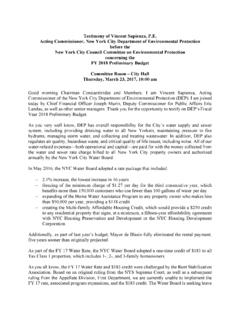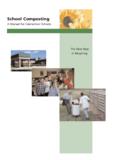Transcription of AUTHORS' NAMES: PATRICK G MURIUKI …
1 project TITLE: VEGETABLES AND FRUITS PRODUCTION FOR CHILDREN NUTRITION IN KENYA( project AREA: Schools in Marginal Areas of Central and Eastern Provinces) authors ' NAMES: PATRICK G MURIUKIINSTITUTION: INTERGRATED COMMUNITY ORGANIZATION FOR SUSTAINABLE EMPOWERMENT AND EDUCATION FOR DEVELOPMENT (ICOSEED)E-mail: & Fax numbers: +254 720468046/ +254 202640561 INTERGRATED COMMUNITY ORGANIZATION FOR SUSTAINABLE EMPOWERMENT AND EDUCATION FOR DEVELOPMENT HEAD OFFICE-NAIROBINGONG ROAD; JAMESON COURT;BLOCK D, SUIT 2, GROUND FLOOR; BOX 4729 00506, NAIROBI OTHER OUT REACH OFFICES(Kerugoya, Meru, Embu & Kitui)INTRODUCTION; VISION AND MISSIONI coseed is the Acronym of Integrated Community Organization for Sustainable Empowerment and Education for Development . The organization is a not-for-profit Development Organization. VISION:To be the leading Humanity Development Institution in Kenya and in Africa to instill hope and healing in the midst of human sufferings and enhance potentials for community sustainable social-economic Development through capacity building in community's felt needs raised in participatory :To empower the poor, the destitute, the marginalized and the less privileged community members to discover and harness their potentials towards self sustainability in food, health, wealth, Education and spiritual well being.
2 Gideon M. MakangaThe chairman PATRICK G. MuriukiSecretary/MDDR. R. K. WanjoguVice ChairmanNelson MURIUKI RintariTreasurerMr. Peter MuriithiThe patronMANAGEMENT AND ADMINISTATIONI coseed Kenya is managed by 7 able and committed board members who make deliberate efforts to reduce human sufferings through formulation of policies, rules and regulations which guide the staff to reach the poor and destitute for empowerment, discovery and exploitation of potentials for sustainable AND VEGETABLES project INTRODUCTIONR ationale of the projectFruits and vegetables farming using drip irrigation and intensive land management targeted 50 primary and secondary schools in marginal parts of Eastern and Central provinces of Kenya to address malnutrition and related health problems. Icoseed facilitated school gardening and nutrition education programme to improve the health of the school going children and therefore improve their ability to , 45,000 children were targeted to access fruits and vegetables in their meals every day in schools.
3 Another 19,700 adults learnt how to produce fruits and vegetables by drip irrigation from the schools gardens. Map of Kenya showing project AreaBACKGROUND The project is situated in marginal areas of Central and Eastern provinces of Kenya. The project mainly covers the lower parts of Kirinyaga, Embu, Mbeere, Meru, and Ukambani Districts/counties. Generally these areas are marginal in terms of rainfall. The region has approximately 1,167471 people of whom 65% is youth and school going children. 85% of the people are semi illiterate and there fore not cognitive of the un taped resources in the communityCont The main social economic activities include subsistence farming and trade with the farm products and livestock. Maize, sorghums, green grams, pigeon peas and beans are the main food crops grown. Due to unreliability of the rainfall the area experiences frequent famine. Cont During the dry weather the youth are idle due to lack of jobs.
4 This influences them to sexual activities and other evil activities; predisposing them to HIV/Aids Charcoal burning and illicit brew making is common in these areas. This poses a serious environmental challenge in the ANALYSISP roblem description-Malnutrition is a serious problem in sub Saharan Africa and particularly in marginal and ASALs areas of Kenya. More so, this is an acute problem in Eastern province of Kenya and its neighboring parts of Central province. -In these areas, the poverty levels are extremely high and this exacerbates vulnerability of children, youth and the aged to potential health risks. -Poverty levels ranges between 43% in parts of central province to 78% and 81% in parts of Meru and Ukambani Districts respectively (Source: The Geographical Dimensions of Well being in Kenya Vol. II 2005)Cont - Unemployment rate is very high-85% There is high malnutrition rate coupled with declining school attendance rates despite a free primary education programme in Kenya.
5 Among the school going children, 81% arrive at school hungry. In some schools with Government of Kenya / WFP school feeding programme, the lunch given constitutes the only reasonable meal they may receive in a day. The meal whose ingredients is maize and beans lacks fruits and vegetables which are the major source of vitamins and 'S OBJECTIVES To increase the nutritional value of school lunches. To improve the nutritional and health status of children in program schools. To increase teachers , cafeteria workers and children s knowledge of gardening and nutrition . To develop a model for institutional, behavioral and financial sustainability To integrate cross-cutting lessons of environmental conservation and HIV and AIDs in the school gardening education and trainingTARGET POPULATION Approximately, 45,000 school going children from were targeted to access fruits and vegetables in their meals every day in schools by producing them. Another 19,700 adults were targeted to learn how to produce fruits and vegetables by drip irrigation from the schools gardens Direct beneficiaries39,056 school going children in secondary and primary schools were the direct beneficiaries of the project .
6 In these schools, 456 teachers and 874 workers benefited directly from the project . Indirect beneficiariesAnother 78,000 people from the surrounding community benefited from this project To achieve the objectives; Icoseed organized farmers into groups & Schools for PACE using the Rehovot Approach to Sustainable Development Nutrition and gardening education programme and materials provision for school children Development of school gardens, utilization of intensive gardening techniques. Training of teachers as ToTs and training of other teachers Training of community opinion leaders on project and how they could use the power of social and financial capital to replicate what was being demonstrated in schools. Work with the government officials to integrate the programme into the local infrastructurePROJECT RESPONSIBILITY AND MANAGEMENT InstitutionsThis project was lead by Icoseed - local Ngo in Kenya. The Ministries of education & Agriculture, school boards & PTAs were integral to project planning and mgt.
7 Private SectorThe private sector was involved to supply and install the drip irrigation kits and farm inputs in schools and in the community members who took up the technology from HEADACTIVITY DESCRIPTION $ project Planning & Laying Implementation Strategy With Local Leaders1,000,00012, Purchasing of 50 Irrigation Kits And Installation7,500,00096, Nutrition & Gardening Education for Parents, children and Teachers3,240,00041, Transport And Subsistence Expenses1,014,00013, Monitoring and evaluation300,0003,850 TOTALS13,054, Administration 20% of cost 2,610,80033,472 GRAND TOTAL15,664,800200, BUDGETFUNDING The project was funded by Monsanto fund However to ensure the schools and the surrounding communities owned up the project , each school contributed one third of the cost of the drip irrigation kits They also provided casual labor and the security of the farm and the farm products from being vandalized by evil RESULTS The 50 primary and secondary schools in the project have established very good acre vegetable and fruits gardens.
8 Pupils, teachers, schools farm attendants and parents have been trained in vegetables and fruits production. They are producing adequate vegetables to feed the children and a little to take to the local market. It is evident that they are saving income they would have spent on vegetables and this is being used to expand their vegetable gardens. There is replication of this work in the neighboring communities. More than 243 new drip irrigation units have been established in the neighborhoods of the pilot Irrigation KitGENERAL IMPACT The project has increased fruits and vegetables in the food basket of the local communities. The school children have been able to access them. According to the school administration, this has improved the learning ability of the school children as indicated by better mean scores recorded in the academic performance assessment cards. There is improved income and or savings from the school gardens. The general health of the pupils and the teachers has generally improved.
9 Equity Bank is interested in financing agri business using the drip irrigation technology -it is economical and profitable KEY FACTORS FOR SUCCESS Icoseed adopted participatory methodologies in this project where PPA was conducted using Rehovot approach to development. Teamwork with relevant government ministries, private institutions and community it self. The technical multi-disciplinary team therefore empowered the opinion leaders and the community development committees to implement the project through the is required to implement such a project in other areas? To implement such as this project in another area, it requires conducting a rapid Assessment followed by a comprehensive PACE process. Resource mobilization- both local and external Organize for marketing of surplus products to generate income for sustainabilityLessons for the future The Gate keepers were the business people who trade with schools supplies. Water is an important element in this project .
10 Schools and community water projects should be developed along side popularizing the technology for agric. Huri s experience in Jerusalem was true and important -to work with the Politicians & school boards to give them glory while professionals gave technical guidelines to leap maximum benefits from the project . It was also critical that the staff should concentrate their efforts on a smaller unit to create sustainable impact instead of spreading thinly in a large area. Marginal areas in terms of rainfall are resourceful but require a technology like this one to spur economic and social development that has lasting impact in the communityProposed Way forward Divide the region into 4 programme areas, namely: Isiolo; Meru, Embu & Ukambani Facilitate shallow or deep wells development in 50 schools in each unit Facilitate establishment of 1/2acre irrigated intensive Vegetables and Fruits Gardening in each school Involve the school boards, teachers and students in farming Support marketing of Surplus products to generate income for other schools developmentTHANK YOU





